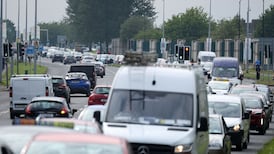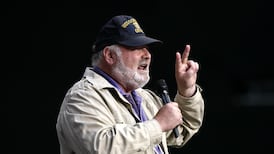Letter from Halabja/Caitriona Palmer: It's difficult to imagine that the sight of a shiny green apple can cause so much heartache. But for the people of Halabja, a Kurdish town in northern Iraq , apples are a potent reminder of a violent, choking death that killed more than 5,000 of the town's residents 16 years ago this week.
"We hate apples in this town," said Mr Aras-Abid Akram, head of the cultural centre of Halabja, "because the smell will always remind us of the chemical attack of 1988."
The sweet aroma of ripe apples, oranges and almonds was the first indication to Halabja residents on the afternoon of March 16th, 1988, that this Iraqi bombardment was like no other.
As people scurried to their basements for cover, a heavy yellow smoke crept steadily across the town. Within seconds hundreds of residents were vomiting a whitish substance and gasping for air. Within minutes thousands were dead.
On the bright, white walls of the memorial hall in Halabja this week, colour photos taken at the time showed exactly what happens when a human breathes in nerve agents, cyanide and mustard gas.
Most people made it no farther than their front doors before collapsing on to the street. Blackened, bloated bodies lay strewn across the doorsteps of simple red-brick homes. Families who never made it out lay inside their homes in huddled heaps, mothers clutching babies, fathers holding toddlers.
More bodies tumbled in a grotesque cascade out of cars and trucks. In one photo a little boy who survived the attack nuzzles his face against the neck of his dead father while ignoring the pleas of an older man to abandon the decomposing body.
At the anniversary commemoration in Halabja, American security concerns meant that families of the victims were barred from the official ceremony. But they didn't miss much. As they waited outside on the street, inside the hall, the head of the US-led coalition authority, Paul Bremer, spoke about how Saddam's chemical attack on Halabja showed that America 's war in Iraq was justified.
But some here view such platitudes as coming a little too late. Sixteen years ago, as America supported Saddam in his war against Iran, few in Washington seemed to care much about Halabja. Now they can't seem to get enough of it.
Everywhere in this dusty town, there is someone desperate to tell their story. In the local cemetery, a badly constructed cement brick wall protects a patch of lush green grass under which lie more than 1,500 victims of the attack.
Next to the wall stands an elderly man, Abdullah, who seems agitated and confused. "I haven't anyone left," he tells me. "I am alone. My seven children, my wife, my brother are in this grave". Abdullah wants to show me something. He fumbles in his coat and with shaking hands pulls out a torn plastic bag. Inside lie the yellowed, worn death certificates of his family.
But down the road from the graveyard the mood is much lighter. At the local art centre Kurdish officials gather for a poetry and song recital to mark the anniversary. Garish bright banners welcome the American and coalition forces as the "liberators of Iraq". Throughout a series of speeches and songs there is no talk of revenge. Instead brightly dressed children in traditional costumes strain to sing lively songs of unity and peace.
At the back of the hall, waiting to go on stage, sits 12-year old Showkan. In his small hands he expertly holds a twitching white dove that he says proudly is a symbol of hope for the future. Born four years after the attack, Showkan is well versed in Halabja's tragic history.
"The Kurdish people of Halabja were attacked by Saddam Hussein," he tells me. "And these attacks broke the heart of Kurdistan. But I think Kurdistan 's heart is much better now".
Showkan may have a point. Halabja's narrow streets are a hive of frantic activity. From small shopfronts merchants peddle fruit, air-conditioners, live chickens and mobile phones. The noise of car horns fills the air. The atmosphere is cheerful, the people extraordinarily welcoming.
"I imagined that there would be no life here any more," says an Iranian man attending the ceremony. He, too, lost his entire family when Saddam's air force dropped chemical bombs on the Iranian town of Sardasht in 1987. "But," he says, "I feel as though life here has grown back slowly, like a plant coming up."
As we drove out of Halabja, about 30 children were engaged in a riotous game of hide-and-seek. Bright faces peeked around doors and over walls as a frustrated little boy tried in vain to find his friends.
The children's laughter was infectious. Even the weary chemical weapon victims who waved us off managed to smile at their antics. It seemed fitting proof that Saddam's genocidal campaign against the Kurds had failed and that life and hope can return to the unlikeliest of places.







